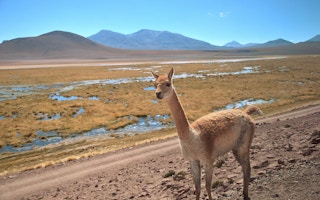Poor and rural people around the world rely on plants and animals for shelter, food, income, and medicine. In fact, the United Nations Sustainable Development Goal (SDG 15) on sustainable ecosystems acknowledges many developing societies’ close relationship with nature when it calls for increased “capacity of local communities to pursue sustainable livelihood opportunities.”
But how is this to be achieved?
The 1975 Convention on International Trade in Endangered Species of Wild Fauna and Flora (CITES) provides a viable framework for reducing poverty while also conserving nature. It regulates the harvesting and exchange of more than 35,000 wildlife species across a range of locales.
Nature has been described as the “GDP of the poor.” The CITES framework, combined with strong national conservation policies, can simultaneously protect wild species and benefit poor, rural, and indigenous people, by encouraging countries and communities to adopt sound environmental management plans.
For example, under CITES, Andes communities shear the vicuña for its fine wool, which they sell to the luxury fashion industry in other parts of the world. Cameroonians collect African cherry bark for export to European pharmaceutical companies. And people on the Tibetan Plateau in Bhutan make a living selling caterpillar fungus to the traditional-medicine industry.
However, outside of CITES, limited guidance is available to ensure that legal trade is sustainable and beneficial to the poor. Sustainable trade often depends on poor and rural communities conserving their own resources at the local level.
To see what that looks like, the International Trade Center (ITC) recently examined how people in Southeast Asia sustainably manage the CITES-listed python trade.
Python skins are commonly used as raw material in the luxury fashion industry, and ITC surveys of python-skin harvesters, farmers, processors, and exporters in Vietnam and Malaysia found that the trade reinforces livelihood resilience by providing an additional source of income.
In Vietnam, an estimated 1,000 households farm and trade pythons, and python harvesting in Malaysia provides incomes for low-skilled, low-income workers during periods when other employment opportunities are either out of season, or simply scarce because of larger economic factors.
Researchers found that most of those harvesting pythons implement simple and effective sustainable-management plans, and that this has reduced pressure on wild populations.
However, python skins, like many wildlife products, are a commodity, so communities harvesting them are limited in terms of how they can add value to increase returns.
Women in the Peruvian Andes may clean vicuña wool by hand to increase the price it fetches per kilogram by $50, whereas selling a wool-scarf could yield them $150-200; a Malaysian python skin sells for $200, while a python-skin bag could sell for $2,000.
Still, some emerging countries are moving up the value chain and retaining a greater share of returns, as demonstrated by local brands such as Kuna, which markets alpaca and vicuña wool in Peru, and Natura, a Brazilian natural-cosmetic brand.
The biggest threats to the legal wildlife trade are poaching, smuggling, improper trade permitting, and animal abuse, all of which must be addressed by regulators and rural community stakeholders at the local level. Fortunately, rural communities are already in the best position to protect wildlife, so long as they are motivated to do so.
In the right circumstances, a virtuous cycle, whereby local producers have a direct interest in protecting wildlife (because they are benefiting from its legal trade) is the best – and sometimes the only – long-term solution to the problem of sustainability.
“
Fortunately, rural communities are already in the best position to protect wildlife, so long as they are motivated to do so.
To help with this, governments can increase rural communities’ resource- and wildlife-use rights so that they can manage and protect their natural resources sustainably.
For example, in the 1970s when Peru granted Andean communities the right to use vicuña wool, it saved the vicuña from extinction and created new, long-term income streams for the community. Because legal and natural circumstances vary by country and community, we will need similar policy innovations across different sectors.
One promising sector is tourism, which also fits into the CITES framework. To take one example, since Rwanda began sharing wildlife-tourism revenues with local communities, the mountain-gorilla population has grown. As we see time and again, when local communities are included, they can become resolute wildlife defenders.
More generally, we should be supporting scientists working on new adaptive-management methods, and the private sector should be given incentives to invest in greater sustainable sourcing and increased supply- and production-chain transparency.
As the examples above show, conservation and improved livelihoods for the rural poor are feasible, and even mutually reinforcing. With more political will and smart investments, there is no reason we can’t reach the SDGs to both reduce poverty and safeguard wildlife for future generations.
Last year, the UN passed an historic resolution to tackle illicit wildlife trafficking, recognizing the effectiveness of the CITES legal framework. The resolution calls on the 182 CITES member countries to protect the interests of wildlife as well as to provide tangible benefits for the poor and rural communities. We hope that delegates from those member countries meeting at the World Wildlife Conference in South Africa are hearing that call.
Arancha González is the Executive Director of the International Trade Center, the joint agency of the United Nations and the World Trade Organization. John E. Scanlon is Secretary-General of the Convention on International Trade in Endangered Species of Wild Fauna and Flora (CITES).
Copyright: Project Syndicate, 2016.
www.project-syndicate.org











